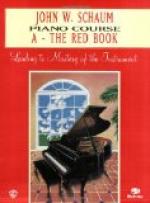THE METRONOME
When the subject of using such a mechanical aid as the metronome to cultivate rhythmic sense, is broached to the executive artist, it does not always meet with an assenting response. With such bred-in-the-bone sense of time as the artist commands, it is little wonder he takes no great interest in mechanical time-beating. Josef Hofmann’s censure of the metronome was probably due to his inborn rhythmic and artistic sense; yet his words have doubtless had their effect on many students, who, lacking his sense of rhythm, would have been greatly benefited by its use.
Godowsky, when asked his opinion of the metronome, replied: “I assuredly approve of its use; I have even devoted a chapter to the metronome in the Progressive Series, my great work on piano playing.” Edwin Hughes remarks: “If pupils have naturally a poor sense of rhythm, there is no remedy equal to practising with the metronome, using it daily until results are evident, when there can be a judicious letting up of the discipline. The mechanical sense of rhythm, the ability to count and to group the notes of a piece correctly, can be taught to any person, if one has the patience; but for the delicate rhythmic nuances required by a Chopin Mazourka or a Viennese Valse, a special rhythmic gift is necessary.”
Artists and teachers who have come under Leschetizky’s influence and use his principles, are generally in favor of the metronome, according to their own testimony. The fact is, they as teachers often find such deficiency in their pupils on the subject of time sense and accuracy in counting, that they are forced to institute strict measures to counteract this lack of rhythmic comprehension.
Granting, then, that the correct use, not the abuse, of the metronome is of great assistance in establishing firm rhythmic sense, let us turn our thought to the fascinating subject of—
TONE COLOR
When De Pachmann affirmed that he uses certain fingers to create certain effects, the idea was thought to be one of the eccentric pianist’s peculiar fancies. Other players, however, have had the same thought, and have worked along the same line—the thought that on the fingering used depends the quality of tone. For instance you might not play an expressive melody with a consecutive use of the fifth finger, which is called a “cold finger” by Thuel Burnham. He would use instead the third, a “warm finger,” to give out a soulful melody.




